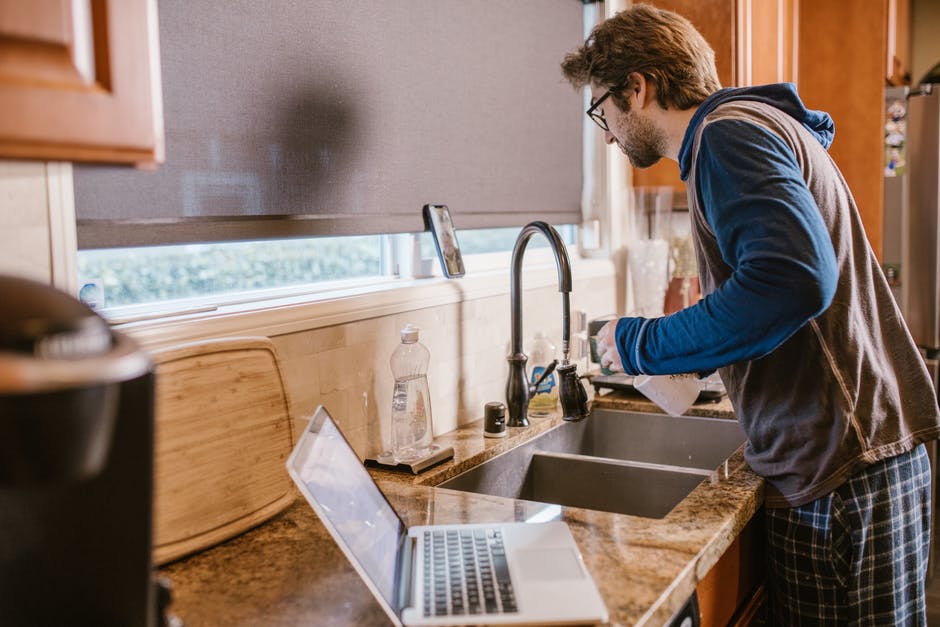Nothing speaks to a messy home quite like an overloaded, dirty kitchen sink. Your kitchen sink is one of the germiest places in your entire house.
This makes sense, given that dishes with all sorts of stuck-on food can get left there to molder and breed ecosystems of bacteria. Your kitchen sink is also a common site of handwashing, produce-washing, meat defrosting, and all sorts of germ-laden activities. All of this is to say, cleaning a kitchen sink the right way is critically important to keeping your family safe and healthy.
Not sure how you can best clean your kitchen sink? No worries! Our helpful guide will tell you everything you need to know.
First, Empty Your Sink
While this should seem obvious, if you want to start cleaning a kitchen sink, you should first empty it. In fact, emptying the kitchen sink can be the largest, most overwhelming part of the work. Especially if you don’t have the time or money to hire a cleaning company or do the dishes yourself.
Once you either load your dishes into the dishwasher or clean and dry them, you need to finish emptying the sink. This means getting all the food particles out of the strainer and off of the basin. You should also make sure you get any dish drainers, sponge holders, or other add-ons out of the sink before you get started with the next step.
Second, Scrub and Rinse
Once your sink is completely empty, it’s time to scrub down and rinse your sink. Grab a mild dish soap, some water, and a sponge or brush. Then, scrub the basin and exterior of your sink in gentle circular motions. Once you’ve scrubbed the sink clean, rinse off the remaining particles until the soap runs down the drain.
If the initial scrubbing with soap and water doesn’t give you a clean kitchen sink, then you can follow it with a more specialized cleaning solution. However, you have to be careful with different materials.
For a Stainless Steel Sink…
If the initial scrub and rinse doesn’t clean your stainless steel sink, feel free to use more abrasive measures. Make a paste of baking soda and water, followed by a vinegar rinse. The chemical reaction should loosen any remaining grime, cleaning a kitchen sink with ease.
For a Porcelain, Copper, or Granite Sink…
Cleaning a kitchen sink gets much more difficult when it’s made from porcelain, copper, or granite. You can’t use scouring pads or abrasives, here. If dish soap and water doesn’t do the trick, you may need to invest in a cleaner specially created for those materials.
This same principle applies to enameled cast iron sinks as well. If you use abrasive cleaning chemicals or tools, you could scratch your sink, giving germs further breeding grounds.
Third, Work Through Every Nook and Cranny
If you’ve ever seen someone deep cleaning a sink, you’ve probably seen them grab a toothbrush or bottle brush to finish the job. This is because there are loads of tiny crevices in which food, dead skin cells, and other nasties can live rent-free.
Be honest: Even if you clean your kitchen sink on a regular basis, how often are you cleaning around and under the junction between sink and counter? Behind your faucets and at the base of the handles? In the grooves of the sprayer handle?
We thought not. So, if you want a clean kitchen sink, don’t neglect this crucial step. You may dislodge food particles or mold that you didn’t even realize lurked beneath your nose.
Fourth, Disinfect Thoroughly
After you’ve cleaned every nook and cranny of your kitchen sink, you need to disinfect it thoroughly. Bleach and bleach-based cleaners are by far the most popular and most effective. However, if you can’t tolerate the smell of bleach or wish to limit your exposure to strong chemicals, then you can also use a mixture of natural disinfectants.
While you’re disinfecting the sink, don’t forget to wipe down all the most commonly touched surfaces. Disinfect your faucet and sink handles to ensure that bacteria and viruses don’t have a chance to breed and multiply.
Don’t Forget the Garbage Disposal
Not every kitchen sink has a garbage disposal. However, if you intend on deep cleaning a sink without outside assistance, you can’t neglect this crucial step.
To clean your garbage disposal, stop up the drain and fill the sink with warm, soapy water. Once the sink is full, open the drain and run the disposal, filling it with a cup of ice and half a cup of salt. Let the disposal run for a bit, then turn it off and add a half cup of baking soda.
Let that mixture sit in the sink for about an hour before adding half a cup of vinegar to the mix. Run the cold water tap and then turn on the disposal for a minute.
How to Keep a Clean Kitchen Sink Tidy
Of course, the trickiest part of kitchen sink cleaning is keeping it clean once you’re done. If you want to keep your sink clean, make sure you don’t leave food scraps and dishes sitting there. Clean up after you finish cooking and wipe down your sink with disinfectant at least once a week to keep it from becoming grimy and germ-filled.
Cleaning a Kitchen Sink: Let’s Review the Basics
Let’s review what you need to know about cleaning a kitchen sink, step by step. First, make sure you empty the sink in its entirety. After that, scrub it down and rinse it, taking care to use the right tools and cleaners for your sink. Then, after cleaning every nook and cranny, disinfect the sink from top to bottom and clean out the garbage disposal.
If you follow these steps, you can obtain and then maintain a clean kitchen sink. However, if you need further help to keep your kitchen, sink included, sparkly and shiny, don’t hesitate. Inquire at MaidLuxe today! Our trained home-cleaning professionals are more than happy to help you.









